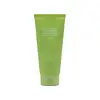What's inside
What's inside
 Key Ingredients
Key Ingredients

 Benefits
Benefits

 Concerns
Concerns

 Ingredients Side-by-side
Ingredients Side-by-side

Water
Skin ConditioningGlycerin
HumectantSodium Cocoyl Isethionate
CleansingCoconut Acid
CleansingCocamidopropyl Betaine
CleansingGlycol Distearate
EmollientPalmitic Acid
EmollientPotassium Cocoyl Glycinate
Sodium Methyl Cocoyl Taurate
Cleansing1,2-Hexanediol
Skin ConditioningStearic Acid
CleansingSodium Isethionate
CleansingSodium Chloride
MaskingPotassium Cocoate
EmulsifyingCamellia Sinensis Leaf Extract
AntimicrobialPolyquaternium-67
Citric Acid
BufferingSaponaria Officinalis Leaf/Root Extract
Skin ConditioningCamellia Sinensis Seed Oil
HumectantBarm Extract
Skin ConditioningEthylhexylglycerin
Skin ConditioningMelia Azadirachta Leaf Extract
Skin ConditioningDisodium EDTA
Melia Azadirachta Flower Extract
Skin ConditioningAllantoin
Skin ConditioningSodium Hyaluronate
HumectantLactobacillus Ferment
Skin ConditioningHyaluronic Acid
HumectantHydrolyzed Hyaluronic Acid
HumectantHydroxypropyltrimonium Hyaluronate
Potassium Hyaluronate
Skin ConditioningSodium Hyaluronate Crosspolymer
HumectantPentylene Glycol
Skin ConditioningSodium Acetylated Hyaluronate
HumectantWater, Glycerin, Sodium Cocoyl Isethionate, Coconut Acid, Cocamidopropyl Betaine, Glycol Distearate, Palmitic Acid, Potassium Cocoyl Glycinate, Sodium Methyl Cocoyl Taurate, 1,2-Hexanediol, Stearic Acid, Sodium Isethionate, Sodium Chloride, Potassium Cocoate, Camellia Sinensis Leaf Extract, Polyquaternium-67, Citric Acid, Saponaria Officinalis Leaf/Root Extract, Camellia Sinensis Seed Oil, Barm Extract, Ethylhexylglycerin, Melia Azadirachta Leaf Extract, Disodium EDTA, Melia Azadirachta Flower Extract, Allantoin, Sodium Hyaluronate, Lactobacillus Ferment, Hyaluronic Acid, Hydrolyzed Hyaluronic Acid, Hydroxypropyltrimonium Hyaluronate, Potassium Hyaluronate, Sodium Hyaluronate Crosspolymer, Pentylene Glycol, Sodium Acetylated Hyaluronate
Water
Skin ConditioningCoco-Betaine
CleansingSodium Lauroyl Methyl Isethionate
CleansingSodium Chloride
MaskingAcrylates/C10-30 Alkyl Acrylate Crosspolymer
Emulsion StabilisingTromethamine
BufferingHydroxyacetophenone
AntioxidantSodium Methyl Isethionate
EmulsifyingPanthenol
Skin ConditioningAllantoin
Skin ConditioningBambusa Vulgaris Extract
Skin ConditioningLauric Acid
CleansingMelaleuca Alternifolia Leaf Oil
AntioxidantSodium Laurate
CleansingEthylhexylglycerin
Skin Conditioning1,2-Hexanediol
Skin ConditioningBetaine
HumectantDisodium EDTA
Water, Coco-Betaine, Sodium Lauroyl Methyl Isethionate, Sodium Chloride, Acrylates/C10-30 Alkyl Acrylate Crosspolymer, Tromethamine, Hydroxyacetophenone, Sodium Methyl Isethionate, Panthenol, Allantoin, Bambusa Vulgaris Extract, Lauric Acid, Melaleuca Alternifolia Leaf Oil, Sodium Laurate, Ethylhexylglycerin, 1,2-Hexanediol, Betaine, Disodium EDTA
 Reviews
Reviews

Ingredients Explained
These ingredients are found in both products.
Ingredients higher up in an ingredient list are typically present in a larger amount.
1,2-Hexanediol is a synthetic liquid and another multi-functional powerhouse.
It is a:
- Humectant, drawing moisture into the skin
- Emollient, helping to soften skin
- Solvent, dispersing and stabilizing formulas
- Preservative booster, enhancing the antimicrobial activity of other preservatives
Allantoin is a soothing ingredient known for its protective and moisturizingg properties. Because of this, it is often added to products with strong active ingredients.
Studies show higher concentrations of this ingredient can promote wound healing.
Though it can be derived from the comfrey plant, allantoin is produced synthetically for cosmetic products to ensure purity.
Learn more about AllantoinDisodium EDTA plays a role in making products more stable by aiding other preservatives.
It is a chelating agent, meaning it neutralizes metal ions that may be found in a product.
Disodium EDTA is a salt of edetic acid and is found to be safe in cosmetic ingredients.
Learn more about Disodium EDTAEthylhexylglycerin (we can't pronounce this either) is commonly used as a preservative and skin softener. It is derived from glyceryl.
You might see Ethylhexylglycerin often paired with other preservatives such as phenoxyethanol. Ethylhexylglycerin has been found to increase the effectiveness of these other preservatives.
Chances are, you eat sodium chloride every day. Sodium Chloride is also known as table salt.
This ingredient has many purposes in skincare: thickener, emulsifier, and exfoliator.
You'll most likely find this ingredient in cleansers where it is used to create a gel-like texture. As an emulsifier, it also prevents ingredients from separating.
There is much debate on whether this ingredient is comedogenic. The short answer - comedogenic ratings don't tell the whole story. Learn more about comegodenic ratings here.
The concensus about this ingredient causing acne seems to be divided. Research is needed to understand if this ingredient does cause acne.
Scrubs may use salt as the primary exfoliating ingredient.
Learn more about Sodium ChlorideWater. It's the most common cosmetic ingredient of all. You'll usually see it at the top of ingredient lists, meaning that it makes up the largest part of the product.
So why is it so popular? Water most often acts as a solvent - this means that it helps dissolve other ingredients into the formulation.
You'll also recognize water as that liquid we all need to stay alive. If you see this, drink a glass of water. Stay hydrated!
Learn more about Water